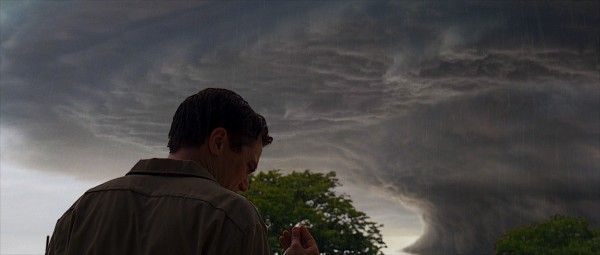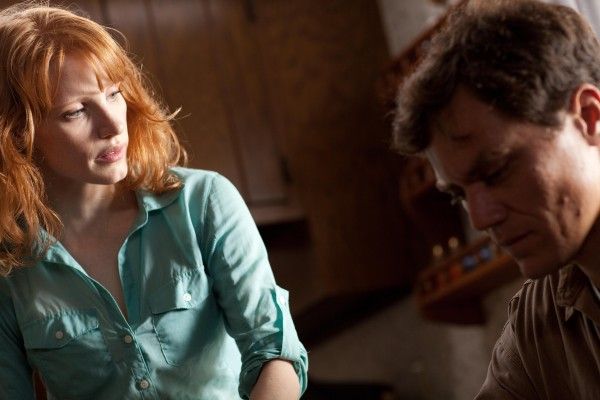Before the screening of Take Shelter, writer-director Jeff Nichols explained to the audience that he was attempting to tap into an emotion of dread and anxiety. For the first act of his movie, he’s wildly successful at capturing that feeling. Vivid, nightmarish dream sequences set the film up as a paranoid thriller. But then Nichols hits the breaks, stops the dreams, and the tension slowly leaves the picture as it moves at a glacial pace. While he’s able to eventually pick it back up at the end and come to an interesting conclusion, he is never able to reconnect with his audience.Take Shelter opens with Curtis (Michael Shannon) having a vision of a storm. Thick, viscous rain falls from the sky and thunder shakes the landscape. The vision passes and Curtis goes back to his normal life as a family man with loving wife Sam (Jessica Chastain) and daughter Hannah (Tova Stewart). But then Curtis tarts to have nightmares. The nightmares always begin with a storm and end with Curtis waking up in pain and paranoia. He believes that his nightmares are premonitions of an apocalypse and so he takes to expanding the storm shelter in his backyard. Desperate to protect his family, Curtis has only two dark options: either he’s wrong and he’s starting to show signs of schizophrenia like his mother (Kathy Baker) or it’s the end of the world. When we see Curtis’ dreams, the film slaps us awake and Nichols is able to create the sense of dread he wants to achieve. He not only brings in the surreal aspects of the dream to affect Curtis’ waking life, but during Curtis’ waking hours, Nichols skillfully weaves in real fears about the economy and health care that all middle-class families are facing right now. Curtis has a good job working construction and his company’s health care plan can pay for his deaf daughter to get a cochlear implant. But as his fear of a cataclysmic event deepens, his attention to his daily life, along with his sanity, begins to unravel.I applaud Nichols for trying to tie in legitimate wide-spread fears with Curtis’ fear of the storm. Adam Stone’s cinematography is gorgeous and full of stark colors and contrast.  However, when the film hits the second act, Nichols’ drops the dreams and slows the pacing to a crawl. The only intensity to permeate the scenes is Shannon’s eternal grimace. I’m a big fan of Shannon, but Nichols over-indulges his lead actor and lets him pause for what seems like five minutes before every line of dialogue. Without giving too much away, Nichols is able to get the movie back on track in the last twenty minutes by finally pushing Curtis and Sam’s relationship to a turning point. But by then the damage is done and we’ve been dragged along too slowly to feel invested in the characters despite the strong visuals and performances.
When we see Curtis’ dreams, the film slaps us awake and Nichols is able to create the sense of dread he wants to achieve. He not only brings in the surreal aspects of the dream to affect Curtis’ waking life, but during Curtis’ waking hours, Nichols skillfully weaves in real fears about the economy and health care that all middle-class families are facing right now. Curtis has a good job working construction and his company’s health care plan can pay for his deaf daughter to get a cochlear implant. But as his fear of a cataclysmic event deepens, his attention to his daily life, along with his sanity, begins to unravel.I applaud Nichols for trying to tie in legitimate wide-spread fears with Curtis’ fear of the storm. Adam Stone’s cinematography is gorgeous and full of stark colors and contrast.  However, when the film hits the second act, Nichols’ drops the dreams and slows the pacing to a crawl. The only intensity to permeate the scenes is Shannon’s eternal grimace. I’m a big fan of Shannon, but Nichols over-indulges his lead actor and lets him pause for what seems like five minutes before every line of dialogue. Without giving too much away, Nichols is able to get the movie back on track in the last twenty minutes by finally pushing Curtis and Sam’s relationship to a turning point. But by then the damage is done and we’ve been dragged along too slowly to feel invested in the characters despite the strong visuals and performances. Take Shelter is almost a brilliant paranoid thriller that slyly taps into contemporary dread. The story just takes too long to get to where it needs to be. I understand Nichols wants to hold tension by keeping scenes quiet and sparse. He’s got a great eye for visuals and his lead actors do solid work. What’s most frustrating about Take Shelter is that there’s a dull, slow-paced drama sandwiched between an intense, paranoid thriller.Rating: C+For all of our coverage of the 2011 Sundance Film Festival, click here. Also, here are links to all of my Sundance reviews so far:
Take Shelter is almost a brilliant paranoid thriller that slyly taps into contemporary dread. The story just takes too long to get to where it needs to be. I understand Nichols wants to hold tension by keeping scenes quiet and sparse. He’s got a great eye for visuals and his lead actors do solid work. What’s most frustrating about Take Shelter is that there’s a dull, slow-paced drama sandwiched between an intense, paranoid thriller.Rating: C+For all of our coverage of the 2011 Sundance Film Festival, click here. Also, here are links to all of my Sundance reviews so far:
- Being Elmo: A Puppeteer’s Journey
- Benavides Born
- Bobby Fischer Against the World
- Corman’s World: Exploits of a Hollywood Rebel
- The Details
- The Greatest Movie Ever Sold
- Higher Ground
- Hobo with a Shotgun
- Homework
- How to Die in Oregon
- In a Better World
- The Interrupters
- The Lie
- Like Crazy
- Magic Trip
- Martha Marcy May Marlene
- The Music Never Stopped
- My Idiot Brother
- Page One: A Year Inside the New York Times
- Project Nim
- Reagan
- Red State
- Salvation Boulevard
- Submarine
- These Amazing Shadows
- Tyrannosaur
- Win Win

